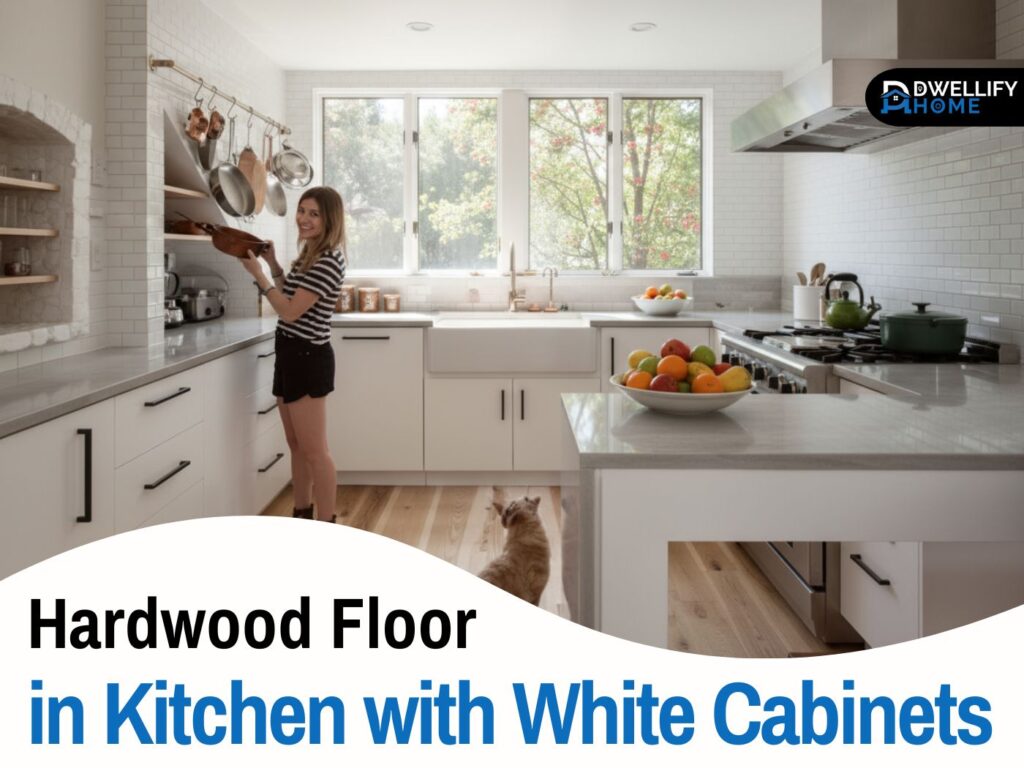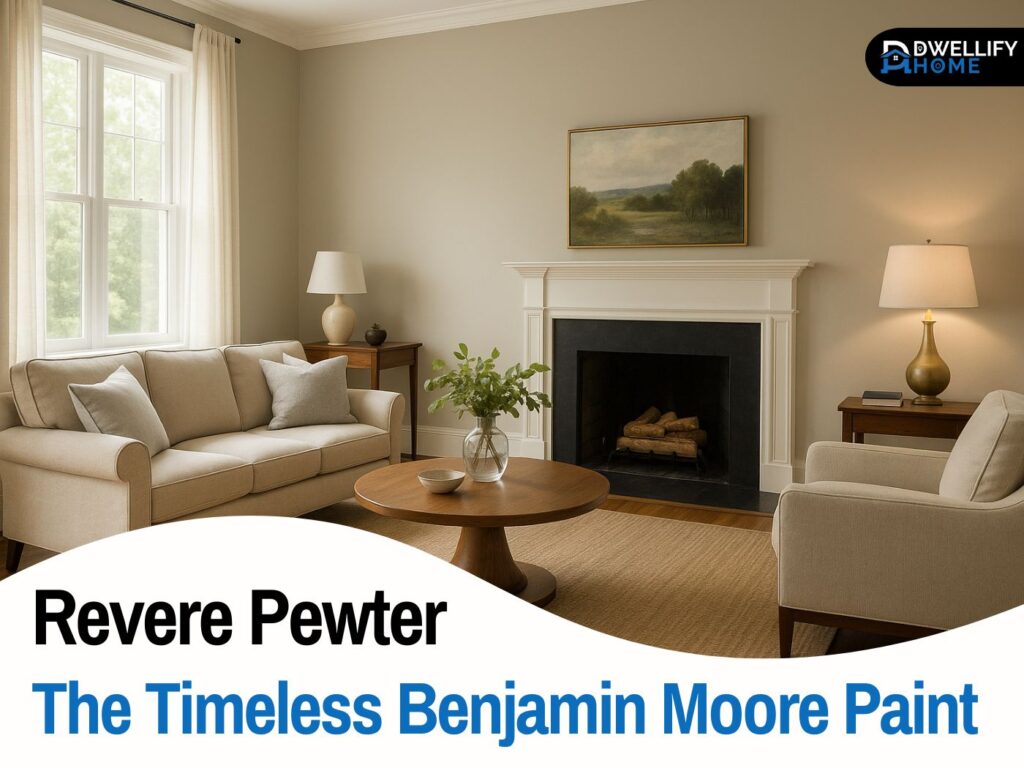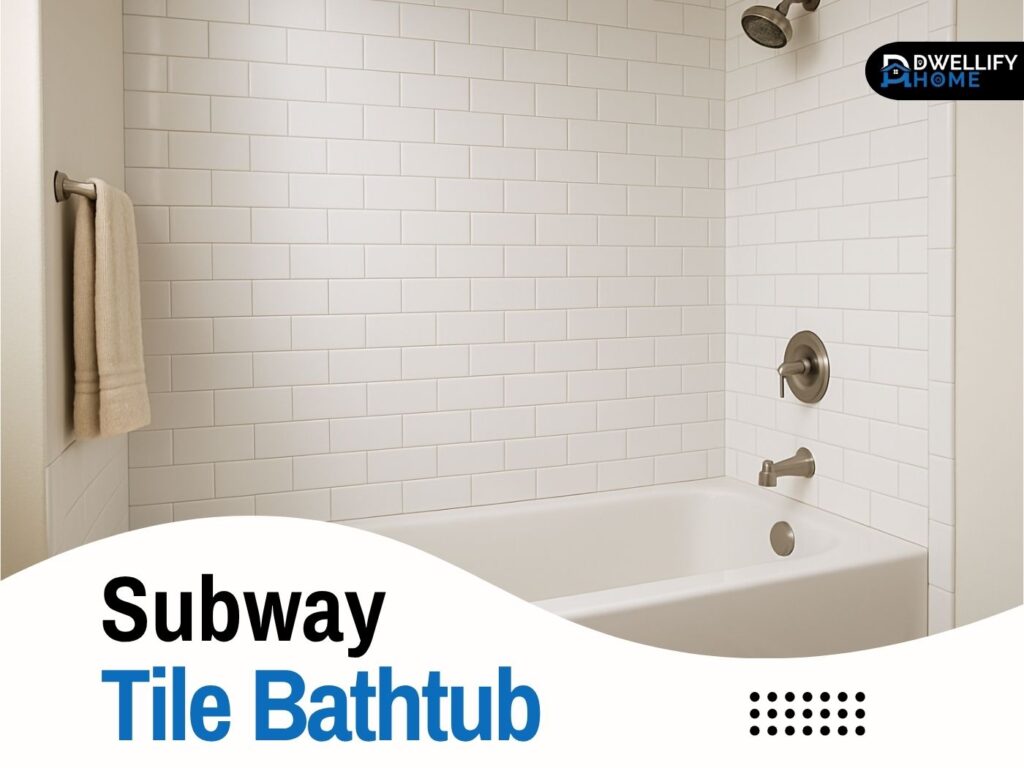When it comes to kitchens, there’s something timeless about pairing hardwood floors with white cabinets. It’s that clean, bright look that never goes out of style — the kind that makes a kitchen feel open, warm, and perfectly balanced. Over the years, I’ve designed dozens of kitchens like this, and every time, the right combination of wood tone and white shade turns an ordinary space into something special.
Here’s the thing — choosing the right floor isn’t just about color. It’s about creating a mood. The right hardwood can make your white cabinets look fresh and elegant, or cozy and rustic. So, let’s walk through how to make it all come together beautifully.
Snippet-Ready Definition:
A hardwood floor in kitchen with white cabinets creates a bright, timeless design. The wood adds warmth, while white cabinets keep the space open, balanced, and inviting for any kitchen style.
Mission Statement
At Dwellify Home, our mission is to inspire beautiful, functional living spaces through expert design insight and honest guidance. We believe every homeowner deserves to create a space that feels warm, personal, and timeless — one detail at a time.
Why Hardwood Floors and White Cabinets Work So Well
White cabinets act like a blank canvas. They reflect light, make small kitchens feel bigger, and match almost any color palette. Hardwood, on the other hand, brings texture and warmth. When you put them together, you get a kitchen that feels both fresh and grounded.
What makes this pairing even better is versatility. Whether your home has a farmhouse charm or a sleek modern vibe, the mix of wood and white can adapt. You can go light for an airy look or dark for dramatic contrast. The key is in balance — how your floor tone complements your cabinets, countertops, and lighting.
Here’s a tip I give homeowners all the time: before choosing your flooring, hold a few wood samples next to your cabinet door under your kitchen lighting. You’ll be surprised how different each one looks depending on the time of day.
Choosing the Right Hardwood Tone
Let’s talk about the fun part — picking your wood tone. There are three main directions you can go: light, medium, or dark hardwood. Each creates a completely different mood.
Light Hardwood Floors
Light woods like ash, maple, and white oak bring an airy, open feeling. They bounce light beautifully and make your kitchen feel larger. If you’re going for a modern farmhouse or Scandinavian-inspired kitchen, this is your best friend.
They pair well with all shades of white — from creamy antique white to crisp cool tones. And they hide dust and pet hair better than darker floors, which is a nice bonus for busy homes.
Designer tip: Add woven textures or a natural rug to tie the light flooring and white cabinets together. It keeps the space from looking too clinical.
Medium Hardwood Floors
Medium tones, like honey oak or hickory, give your kitchen a timeless warmth. They’re right in the sweet spot — not too bold, not too pale. These floors look beautiful with both soft white and slightly warm cabinets, making them perfect for traditional and transitional kitchens.
The best part is their flexibility. Whether you change your wall color, upgrade your countertops, or swap out your backsplash later, medium wood floors usually still fit right in.
Dark Hardwood Floors
Now, if you want contrast and a little drama, go dark. Think espresso, walnut, or mahogany. When matched with bright white cabinets, dark wood floors create a high-end, magazine-worthy look.
Dark floors also anchor the space visually, making your white cabinets pop. But here’s the thing — darker wood shows more dust and scratches, so if you have kids or pets, choose a matte finish to make maintenance easier.
Creating Balance: Matching Floors, Cabinets, and Countertops
Finding the perfect match between your wood floors and white cabinets is all about contrast and harmony.
- If your kitchen is small or doesn’t get much sunlight, choose lighter flooring to keep it open.
- If you have lots of windows or high ceilings, darker wood adds a rich and cozy feel.
- Medium tones work everywhere — they’re like the denim of flooring.
And don’t forget the countertops. For example:
- White cabinets with black countertops pair beautifully with mid-tone brown or warm walnut floors.
- Marble or quartz countertops with subtle veining blend seamlessly with light oak floors.
- Butcher block counters add warmth to white cabinetry when matched with similar-toned flooring.
Backsplash color also matters. A white subway tile keeps things classic, but if you want character, go with handmade tiles or subtle patterns that echo your wood’s undertone.
How Lighting Changes Everything
Lighting is one of the most overlooked elements in kitchen design. Natural light makes wood look lighter and more golden, while artificial lighting can deepen tones or even make white cabinets appear cooler.
Warm lighting (yellow-toned bulbs) makes your kitchen feel inviting and soft. Cool lighting (white or blue-toned) gives it a clean, modern edge. My rule of thumb? Use a mix of both. Add under-cabinet lights to highlight the grain of your wood floor and pendants with warm bulbs for cozy evenings.
If your kitchen doesn’t get much daylight, lean toward light to medium hardwood floors. They’ll reflect light and keep things from feeling heavy.
Practical Choices: Durability and Maintenance
A lot of people hesitate to install hardwood floors in the kitchen because of moisture, but guess what — modern finishes make it completely doable. The key is choosing the right type.
Engineered hardwood is a great option. It’s layered, stable, and less likely to warp from humidity. It looks just like solid wood but handles spills and temperature changes better.
For long-lasting results:
- Use water-resistant finishes.
- Place mats near the sink and dishwasher.
- Wipe up spills immediately.
- Avoid harsh cleaners — use a mild, pH-balanced floor solution.
If you love the look of wood but need something even tougher, laminate hardwood floors or luxury vinyl planks (LVP) are worth exploring. They mimic real wood beautifully, resist water, and work perfectly in busy homes with pets or kids.
Laminate, Vinyl, and Tile Alternatives
Not everyone wants real hardwood, and that’s totally fine. Today’s flooring options are impressive.
Laminate hardwood floor in kitchen with white cabinets gives the same visual warmth at a lower price. It’s scratch-resistant and easy to maintain, though it’s not as moisture-proof as vinyl.
Vinyl flooring with white cabinets has come a long way too. Modern vinyl planks look and feel like natural wood but are completely waterproof. They’re great for kitchens, especially open-concept spaces where spills happen often.
And if you prefer tile, you can’t go wrong with light beige or soft gray tiles. They blend well with white cabinets, especially when paired with wooden accents like bar stools or floating shelves.
Installation and Layout Tips
You’ve chosen your flooring, but how you lay it down makes a huge difference.
- Run floor planks parallel to your main light source (usually a window) for a smooth visual flow.
- For narrow kitchens, lay them lengthwise to create the illusion of a wider space.
- Want something bold? Try herringbone or chevron patterns — they instantly elevate the design.
Remember to leave a small expansion gap around the edges of your floor. Wood naturally expands and contracts with temperature changes, and that tiny gap prevents cracking or warping.
Small Design Details That Change Everything
Sometimes it’s the little things that pull your kitchen together.
- Rugs: A patterned rug in front of the sink adds comfort and color without covering too much floor.
- Hardware: Warm metals like brass or bronze complement honey oak floors, while chrome pairs beautifully with dark walnut.
- Islands: If you’ve got a kitchen island, try painting it a contrasting color — navy, gray, or sage — to break up the white and highlight your hardwood.
And don’t forget lighting. A few pendant lights above the island can bring your whole kitchen to life, highlighting both your wood grain and your cabinetry.
Real-Life Inspiration
I once designed a kitchen for a couple who wanted something bright but cozy. We used light oak hardwood floors, white shaker cabinets, and brushed gold handles. The result? The kitchen felt calm, natural, and timeless. Every morning, sunlight reflected off the wood, creating a soft glow across the room.
Another homeowner went for a dark walnut floor with matte white cabinets. The contrast was stunning — like a black-and-white photograph. Add a few plants and a warm backsplash, and the space looked like it came straight out of a design magazine.
No matter your style, there’s a wood tone that fits your story.
Common Mistakes to Avoid
Here are a few pitfalls you’ll want to steer clear of:
- Choosing a floor color without testing it under your lighting.
- Using too many wood tones (floor, island, and furniture all competing).
- Ignoring moisture protection for hardwood.
- Forgetting rugs in high-traffic areas.
- Picking super glossy finishes that show every smudge.
Always trust your eyes more than samples online. Lighting and shadows can change everything.
Cost, Sustainability, and Smart Choices
Hardwood flooring prices depend on the species and finish. Generally, you’ll spend more for solid oak or walnut, while engineered and laminate options are more budget-friendly. Vinyl plank flooring is the most economical and still looks great.
If sustainability matters to you, look for FSC-certified hardwood or reclaimed wood flooring. These options reduce environmental impact and often have more character than new materials.
Remember — a well-chosen hardwood floor isn’t an expense; it’s an investment in your home’s comfort and value.
Comparison Table: Hardwood Tones with White Cabinets
| Wood Tone | Look & Feel | Best For | Effect |
| Light Hardwood | Airy, modern, and bright | Small or Scandinavian-style kitchens | Makes space look larger and cheerful |
| Medium Hardwood | Balanced and timeless | Traditional or transitional kitchens | Adds warmth and natural depth |
| Dark Hardwood | Elegant and dramatic | Contemporary or luxury kitchens | Creates bold contrast and sophistication |
Quick Step-by-Step Guide: Choosing the Perfect Hardwood Floor
- Check Your Lighting: Observe how natural light hits your kitchen during the day.
- Test Samples: Place wood samples beside your white cabinet door.
- Decide the Mood: Light for open and airy, dark for bold and classy.
- Match Undertones: Warm whites with warm wood, cool whites with gray-toned wood.
- Pick the Finish: Satin or matte finishes work best for durability and a soft sheen.
Final Thoughts
A hardwood floor in kitchen with white cabinets is like the perfect outfit — timeless, elegant, and easy to make your own. Whether you love bright and breezy or rich and dramatic, there’s a combination that fits your taste and lifestyle.
Here’s the best part: you don’t need a huge renovation budget to make it happen. Sometimes all it takes is the right tone of wood, thoughtful lighting, and a few small accents to transform your kitchen into the warm, inviting space you’ve always wanted.
So, take your time, test those samples, and trust your instincts. Because when your kitchen feels like you, every meal feels a little more special.
FAQs
What floors look best with white cabinets?
Light, medium, or dark hardwood all work well — it depends on your style and lighting. Lighter tones create a bright feel, while dark ones add bold contrast.
Is hardwood flooring OK for kitchens?
Yes, as long as it’s sealed properly and cleaned regularly. Engineered hardwood and water-resistant finishes make it a great option.
What color floor goes with white cabinets and black countertops?
Medium or dark brown hardwoods, like walnut or oak, balance the high contrast beautifully.
Can I use vinyl or laminate instead of hardwood?
Absolutely. Both mimic real wood well and are more water-resistant — ideal for busy kitchens.
How do I protect my hardwood floor?
Use rugs near the sink and dishwasher, wipe spills right away, and clean with mild products made for wood floors.
What color hardwood floors go with white cabinets?
Light, medium, and dark tones all work — it depends on your lighting and style. Light oak feels fresh and modern, while walnut or espresso adds elegant contrast.
Should wood floors be lighter or darker than kitchen cabinets?
If your cabinets are pure white, either works. Light floors make the room airy; dark floors ground the space and highlight your cabinetry.
What wood looks best with white cabinets?
Oak, maple, and walnut are the most popular. Maple offers brightness, oak feels classic, and walnut brings luxury contrast.
Should your wood floors match your kitchen cabinets?
Not exactly. They should complement each other, not blend completely. Aim for harmony in undertones rather than identical colors.
What flooring is best for kitchens with white cabinets?
Hardwood is timeless, but engineered wood, laminate, or vinyl planks are great moisture-resistant alternatives that look just as beautiful.
Disclaimer
This article is intended for general informational purposes only. While every effort has been made to ensure accuracy, homeowners should consult professional installers or designers for personalized flooring advice suited to their specific space and conditions.

I’m Bilal, the founder of Dwellify Home. With 6 years of practical experience in home remodeling, interior design, and décor consulting, I help people transform their spaces with simple, effective, and affordable ideas. I specialize in offering real-world tips, step-by-step guides, and product recommendations that make home improvement easier and more enjoyable. My mission is to empower homeowners and renters to create functional, beautiful spaces—one thoughtful update at a time.




